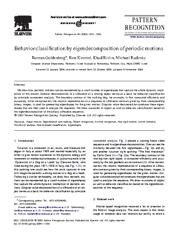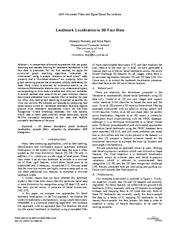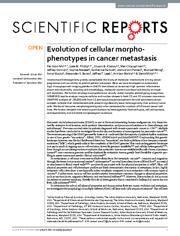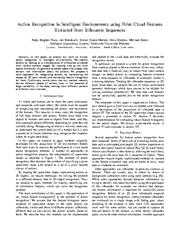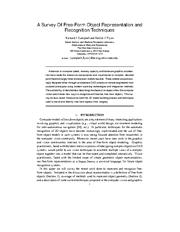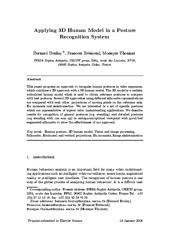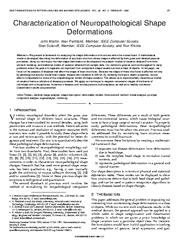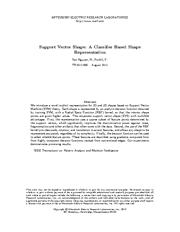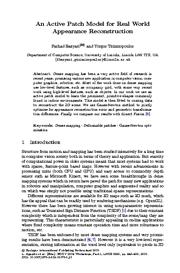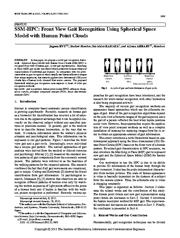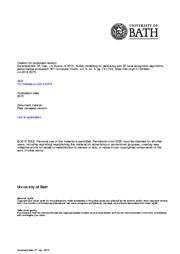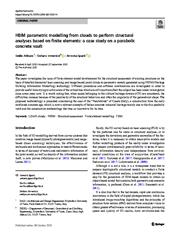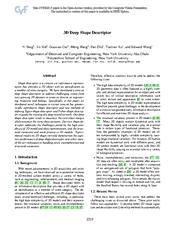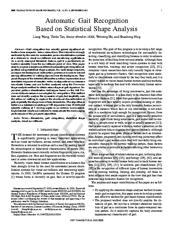A copy of this work was available on the public web and has been preserved in the Wayback Machine. The capture dates from 2017; you can also visit the original URL.
The file type is application/pdf.
Filters
Eigenshapes for 3D object recognition in range data
Proceedings. 1999 IEEE Computer Society Conference on Computer Vision and Pattern Recognition (Cat. No PR00149)
In this paper, we extend the appearance-based recognition scheme to handle range (shape) data. The result of training is a set of'eigensurfaces' that capture the gross shape of the objects. ...
Much of the recent research in object recognition has adopted an appearance-based scheme, wherein objects to be recognized are represented as a collection of prototypes in a multidimensional space spanned ...
Althought this approach only used synthetic data it has shown some interesting properties in using appearance-based methods for range image object recognition under ideal conditions. 1. ...
doi:10.1109/cvpr.1999.784728
dblp:conf/cvpr/CampbellF99
fatcat:i5isuaeuvnb2daznp7klu6pevy
Behavior classification by eigendecomposition of periodic motions
2005
Pattern Recognition
Spectral decomposition of a silhouette of a moving object serves as a basis for behavior classification by principle component analysis. ...
After normalization, the implicit representation of a sequence of silhouette contours given by their corresponding binary images, is used for generating eigenshapes for the given motion. ...
Bruckstein for sharing with us his observation of the connection between the Futurism art movement and the periodic motion presentation using eigenshapes. ...
doi:10.1016/j.patcog.2004.11.024
fatcat:uhbkqyfpg5b5pdqhr66apocxga
Landmark Localisation in 3D Face Data
2009
2009 Sixth IEEE International Conference on Advanced Video and Signal Based Surveillance
A comparison of several approaches that use graph matching and cascade filtering for landmark localisation in 3D face data is presented. ...
We evaluate our systems by computing root mean square errors of estimated landmark locations against ground truth landmark localisations within the 3D Face Recognition Grand Challenge database. ...
Our final objective is a landmark localisation approach robust to extreme pose and facial expression variations, which is relevant to unconstrained face recognition [1] , [4] and the 3D face recognition ...
doi:10.1109/avss.2009.90
dblp:conf/avss/RomeroP09
fatcat:op3jc5x7ejerlj2by4k3saghya
Evolution of cellular morpho-phenotypes in cancer metastasis
2015
Scientific Reports
We further develop a comprehensive visually-aided morpho-phenotyping recognition (VAMPIRE) tool to analyze irregular cellular and nuclear shapes in both 2D and 3D microenvironments. ...
We found the same morphological signature for metastasis for a cohort of 10 breast cancer cell lines. ...
Tseng for critical discussions and reading of the manuscript. ...
doi:10.1038/srep18437
pmid:26675084
pmcid:PMC4682070
fatcat:dnalixayvzdzbcu2od5wtoubxa
Action recognition in intelligent environments using point cloud features extracted from silhouette sequences
2008
RO-MAN 2008 - The 17th IEEE International Symposium on Robot and Human Interactive Communication
We propose a novel approach for recognizing actions, by representing the shapes as 3D point clouds and estimating feature histograms for them. ...
In this paper we present our work on human action recognition in intelligent environments. We classify actions by looking at a time-sequence of silhouettes extracted from various camera images. ...
ACKNOWLEDGEMENTS This work is supported by the CoTeSys (Cognition for Technical Systems) cluster of excellence. ...
doi:10.1109/roman.2008.4600677
dblp:conf/ro-man/RusuBMBB08
fatcat:zonadlqq7be4jdvf7sj2pg6y4q
A Survey Of Free-Form Object Representation and Recognition Techniques
2001
Computer Vision and Image Understanding
The availability of detailed data describing the shape of an object offers the computer vision practitioner new ways to recognize and localize free-form objects. ...
This survey reviews recent literature on both the 3D model building process and techniques used to match and identify free-form objects from imagery. ...
The authors thank three anonymous reviewers and Kevin Bowyer for helpful comments and suggestions. ...
doi:10.1006/cviu.2000.0889
fatcat:lujlciputzdb7e3pjhm4sfknfy
Applying 3D human model in a posture recognition system
2006
Pattern Recognition Letters
We describe results for recognition of general postures (e.g. standing) and detailed postures (e.g standing with one arm up) in ambiguous/optimal viewpoint with good/bad segmented silhouette to show the ...
This paper proposes an approach to recognise human postures in video sequences, which combines a 2D approach with a 3D human model. ...
Acknowledgement This research is leaded in cooperation with STMicroelectronics Rousset under PS26/27 Smart Environment project financed by Conseil Régional Provence-Alpes-Côte d'Azur. ...
doi:10.1016/j.patrec.2006.02.008
fatcat:35lfhrjaqzc57mm4yer75ebq7u
Characterization of neuropathological shape deformations
1998
IEEE Transactions on Pattern Analysis and Machine Intelligence
In this paper, we focus on the analysis of diseases that affect the shape of brain structures. ...
We present a framework for analyzing the shape deformation of structures within the human brain. ...
ACKNOWLEDGMENTS The authors would like to thank Irfan Essa for his many helpful comments, Mike Matsumae for providing the ventricular MR brain data, and Martha Shenton for providing the schizophrenic MR ...
doi:10.1109/34.659928
fatcat:4mj5owwq4vgxzls52sihnw5j4y
Support Vector Shape: A Classifier-Based Shape Representation
2013
IEEE Transactions on Pattern Analysis and Machine Intelligence
We introduce a novel implicit representation for 2D and 3D shapes based on Support Vector Machine (SVM) theory. ...
IEEE Transactions on Pattern Analysis and Machine Intelligence This work may not be copied or reproduced in whole or in part for any commercial purpose. ...
In the second experiment, we perform 3D objects recognition and registration using the publicly available database [42] , which contains 5 objects and 50 scenes. ...
doi:10.1109/tpami.2012.186
pmid:23428433
fatcat:4yvxkixexfeijn73oz263vworm
An Active Patch Model for Real World Appearance Reconstruction
[chapter]
2015
Lecture Notes in Computer Science
In our work we use an active patch model to learn the prominent, primitive shapes commonly found in indoor environments. This model is then fitted to coming data to reconstruct the 3D scene. ...
Most of the work done on dense mapping use low-level features, such as occupancy grid, with some very recent work using high-level features, such as objects. ...
Hence it can work in much wider scale range and can scan objects much farther away from sensor. ...
doi:10.1007/978-3-319-16178-5_31
fatcat:5b4bbotnmjdcpitatsdclftcfu
SSM-HPC: Front View Gait Recognition Using Spherical Space Model with Human Point Clouds
2012
IEICE transactions on information and systems
In comparison with the previous studies on gait recognition which usually use human silhouette images from image sequences, this research applies three dimensional (3D) point clouds data of human body ...
In this paper, we propose a novel gait recognition framework -Spherical Space Model with Human Point Clouds (SSM-HPC) to recognize front view of human gait. ...
Acknowledgments This work was supported in part by a grant of Project for Developing Innovation Systems (Program for Fostering Regional Innovation, Global Type) by the Ministry of Education, Culture, Sports ...
doi:10.1587/transinf.e95.d.1969
fatcat:76offeel3bhndcyguchzhz3lbq
Noise modelling for denoising and three-dimensional face recognition algorithms performance evaluation
2015
IET Computer Vision
The outcome: (1) shows the most reliable parameters for the denoising methods to be used in a 3D face recognition pipeline; (2) shows which parts of the face are more vulnerable to noise and require further ...
Then, by incorporating the noise model in a novel 3D face recognition pipeline, seven different classification and matching methods and six denoising techniques are used to quantify the face recognition ...
These approaches cover a wide range of classification methods and have been extensively used in for holistic 3D face recognition. ...
doi:10.1049/iet-cvi.2014.0379
fatcat:ychliuqcrrebhgs57dzpligsgm
HBIM parametric modelling from clouds to perform structural analyses based on finite elements: a case study on a parabolic concrete vault
2020
Applied Geomatics
Different procedures and software combinations are investigated in order to provide useful hints trying to solve some of the criticalities which are still unsolved albeit the subject has been under investigation ...
The paper investigates the issue of finite element model development for the structural assessment of existing structures on the basis of detailed (terrestrial laser scanning and image-based) point clouds ...
Acknowledgements As part of the overall 3D survey of the site using geomatics techniques, carried out by members of the Geomatics laboratory for cultural heritage of the Polytechnic University of Turin ...
doi:10.1007/s12518-020-00341-4
fatcat:x5j23lhydrbhffwnevqhppywga
3D deep shape descriptor
2015
2015 IEEE Conference on Computer Vision and Pattern Recognition (CVPR)
Our new shape descriptor addresses the challenges posed by the high complexity of 3D model and data representation, and the structural variations and noise present in 3D models. ...
Shape descriptor is a concise yet informative representation that provides a 3D object with an identification as a member of some category. ...
The communication route in blue is for the training of the DNN model, where training data from 3D shape database are used as input. ...
doi:10.1109/cvpr.2015.7298845
dblp:conf/cvpr/FangXDWZXW15
fatcat:4gibzu7ldrddde6kqebpc3m5xi
Automatic gait recognition based on statistical shape analysis
2003
IEEE Transactions on Image Processing
Supervised pattern classification techniques based on the full Procrustes distance measure are adopted for recognition. ...
This interest is strongly motivated by the need for automated person identification systems at a distance in visual surveillance and monitoring applications. ...
., for providing us with the SOTON database. ...
doi:10.1109/tip.2003.815251
pmid:18237983
fatcat:5eahkomnojcnxlq53fbrjl6xii
« Previous
Showing results 1 — 15 out of 73 results


